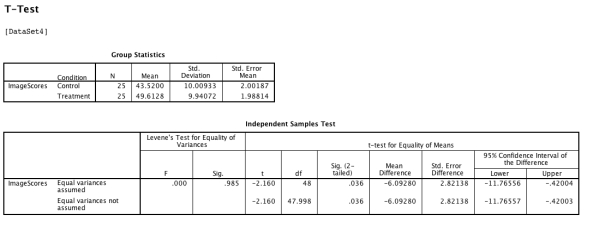After careful ethical review of planned procedures, a researcher tests a new brain activation drug by taking a sample of 50 volunteers and randomly assigning 25 participants to the treatment condition and 25 to the control (placebo) condition.She then carries out an fMRI scan to assess the level of activation in regions of the participants' brains 30 minutes after administering the drug.She carries out a between-participants t-test in SPSS which provides the output shown below:  Which of the following statements is true?
Which of the following statements is true?
A) The assumption of equal variance is irrelevant.
B) The assumption of equal variance is violated.
C) The assumption of equal variance might be violated but we cannot tell from this output as we only have standard deviations
D) We cannot judge whether the assumption of equal variances is violated as we need to see the population distribution.
E) None of the above.
Correct Answer:
Verified
Q5: Which of the following does not compromise
Q6: If an experimenter conducts a t-test to
Q7: If an experimenter conducts a t-test to
Q8: A clinical neuropsychologist develops a new treatment
Q9: "The hypothetical distribution of differences between the
Q11: A clinical neuropsychologist develops a new treatment
Q12: A psychology professor has set a test
Q13: After careful ethical review of planned procedures,
Q14: A psychology professor has set a test
Q15: "An estimated range of values for a
Unlock this Answer For Free Now!
View this answer and more for free by performing one of the following actions

Scan the QR code to install the App and get 2 free unlocks

Unlock quizzes for free by uploading documents